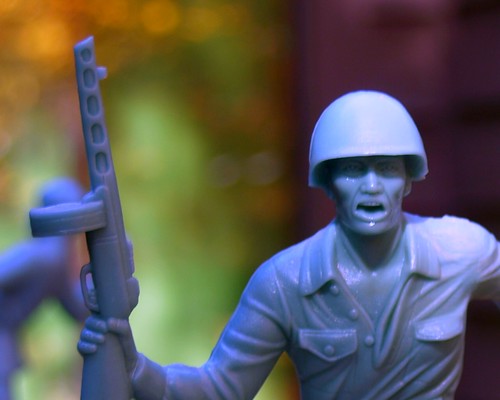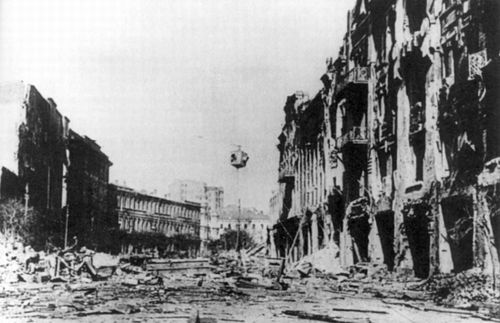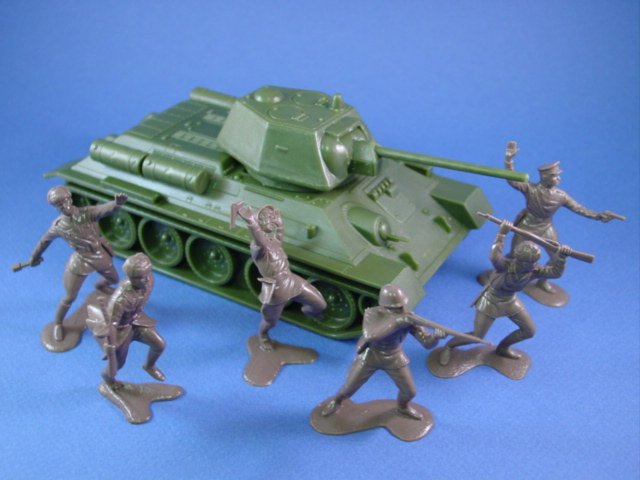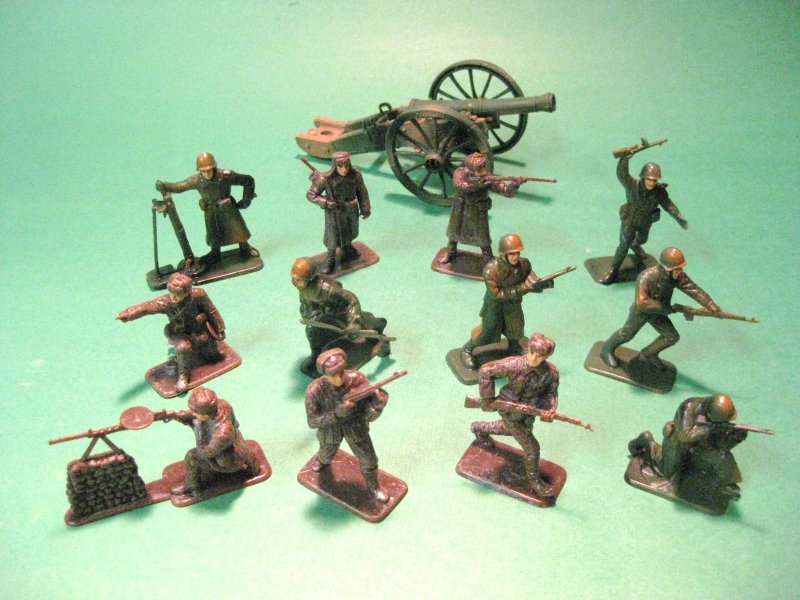 The Battle of Kiev was the German name for the operation that resulted in a very large encirclement of Soviet troops in the vicinity of Kiev during World War II. It is considered the largest encirclement of troops in history.
The Battle of Kiev was the German name for the operation that resulted in a very large encirclement of Soviet troops in the vicinity of Kiev during World War II. It is considered the largest encirclement of troops in history.
Nearly the entire Southwestern Front of the Red Army was encircled with the Germans claiming 665,000 captured. However, the Kiev encirclement was not complete, and small groups of Red Army troops managed to escape the cauldron days after the German pincers met east of the city, including head quarters of Marshall Semyon  Budyonny, Marshall Semen Timoshenko
Budyonny, Marshall Semen Timoshenko  andCommissar Nikita Khrushchev.
andCommissar Nikita Khrushchev. The commander of the Southwestern Front—Mikhail Kirponos—was
The commander of the Southwestern Front—Mikhail Kirponos—was trapped behind enemy lines and killed while trying to break through. T
trapped behind enemy lines and killed while trying to break through. TDBg!~~_12.JPG) he Kiev disaster was an unprecedented defeat for the Red Army, exceeding even the Minsk tragedy of June–July 1941. On 1 September, the Southwestern Front numbered 752–760,000 troops (850,000 including reserves and rear service organs), 3,923 guns & mortars, 114 tanks and 167 combat aircraft.
he Kiev disaster was an unprecedented defeat for the Red Army, exceeding even the Minsk tragedy of June–July 1941. On 1 September, the Southwestern Front numbered 752–760,000 troops (850,000 including reserves and rear service organs), 3,923 guns & mortars, 114 tanks and 167 combat aircraft.
 Budyonny, Marshall Semen Timoshenko
Budyonny, Marshall Semen Timoshenko  andCommissar Nikita Khrushchev.
andCommissar Nikita Khrushchev. The commander of the Southwestern Front—Mikhail Kirponos—was
The commander of the Southwestern Front—Mikhail Kirponos—was trapped behind enemy lines and killed while trying to break through. T
trapped behind enemy lines and killed while trying to break through. T
The encirclement trapped 452,700 troops, 2,642 guns & mortars and 64 tanks, of which scarcely 15,000 escaped from the encirclement by 2 October. Overall, the Southwestern Front suffered 700,544 casualties, including 616,304 killed, captured, or missing during the month-long Battle for Kiev. As a result, four Soviet field armies  (5th, 37th, 26th, and 21st) consisting of 43 divisions virtually ceased to exist. The 40th Army was badly affected as well. Like the Western Front before it, the Southwestern Front had to be recreated almost from scratch
(5th, 37th, 26th, and 21st) consisting of 43 divisions virtually ceased to exist. The 40th Army was badly affected as well. Like the Western Front before it, the Southwestern Front had to be recreated almost from scratch
After the initial success of the Wehrmacht in the Central sector of the Eastern front, a huge bulge in the south remained where a substantial Soviet force of nearly the entire Southwestern Front was located in and around Kiev. While lacking mobility and armor due to high losses in tanks at the Battle of Uman, they nonetheless posed a significant threat to the German advance and were the largest single concentration of Soviet troops on the Eastern Front at that time.

After the initial success of the Wehrmacht in the Central sector of the Eastern front, a huge bulge in the south remained where a substantial Soviet force of nearly the entire Southwestern Front was located in and around Kiev. While lacking mobility and armor due to high losses in tanks at the Battle of Uman, they nonetheless posed a significant threat to the German advance and were the largest single concentration of Soviet troops on the Eastern Front at that time.

At the end of August, the German Army High Command (Oberkommando des Heeres, or OKH) had the option of  either continuing the advance on Moscow, or putting that goal aside temporarily in favor of assisting the other two army groups (North and South) both of which lagged behind.
either continuing the advance on Moscow, or putting that goal aside temporarily in favor of assisting the other two army groups (North and South) both of which lagged behind.
 either continuing the advance on Moscow, or putting that goal aside temporarily in favor of assisting the other two army groups (North and South) both of which lagged behind.
either continuing the advance on Moscow, or putting that goal aside temporarily in favor of assisting the other two army groups (North and South) both of which lagged behind.Because the German Army Group South (Heeresgruppe Süd) lacked sufficient strength to encircle and destroy Budyonny's forces, a significant contribution from Army Group Centre was sent to accomplish the task.

On August 3, Hitler temporarily cancelled the drive on Moscow in favor of driving south and attacking Kiev in the Ukraine.

The bulk of Panzergruppe 2 and the 2 Armee were detached from Army Group Centre and sent due south.It's mission was to encircle Budyonny's Southwestern Front in conjunction with Army Group South whose 
Panzergruppe 1 under Field Marshall Kleist had outflanked Kiev in a southeasternly direction.The Panzer armies made rapid progress. On September 12, Kleist's Panzergruppe 1, which had by now turned north and crossed the Dneiper River, emerged from its bridgeheads at Cherkassy and Kremenchug. Continuing north, it cut across the rear of
which had by now turned north and crossed the Dneiper River, emerged from its bridgeheads at Cherkassy and Kremenchug. Continuing north, it cut across the rear of
Budyonny's forces. On September 16, it made contact with Guderian's Panzergruppe 2 advancing south at the town of Lokhvitsa, 120 miles behind Kiev.
Budyonny was now trapped and soon relieved by Stalin's order of 13 September. No successor was named, leaving the troops to their individual corps and division commanders.


Panzergruppe 1 under Field Marshall Kleist had outflanked Kiev in a southeasternly direction.The Panzer armies made rapid progress. On September 12, Kleist's Panzergruppe 1,
 which had by now turned north and crossed the Dneiper River, emerged from its bridgeheads at Cherkassy and Kremenchug. Continuing north, it cut across the rear of
which had by now turned north and crossed the Dneiper River, emerged from its bridgeheads at Cherkassy and Kremenchug. Continuing north, it cut across the rear of Budyonny's forces. On September 16, it made contact with Guderian's Panzergruppe 2 advancing south at the town of Lokhvitsa, 120 miles behind Kiev.

Budyonny was now trapped and soon relieved by Stalin's order of 13 September. No successor was named, leaving the troops to their individual corps and division commanders.

After that, the fate of the encircled Russian armies was sealed. With no mobile forces or supreme commander left, there was no possibility to effect a break out. The infantry of the German 17. Armee and 6. Armee of Army  Group South soon arrived, along with 2nd Army (also on loan from Army Group Center and marching behind
Group South soon arrived, along with 2nd Army (also on loan from Army Group Center and marching behind  Guderian's tanks). They systematically began to reduce the pocket assisted by the two Panzer armies. The encircled Soviet armies at Kiev did not give up easily.
Guderian's tanks). They systematically began to reduce the pocket assisted by the two Panzer armies. The encircled Soviet armies at Kiev did not give up easily.  A savage battle in which the Soviets were bombarded by artillery, tanks and aircraft had to be fought before the
A savage battle in which the Soviets were bombarded by artillery, tanks and aircraft had to be fought before the  pocket was overcome. By 19 September, Kiev had fallen, but the encirclement battle continued.
pocket was overcome. By 19 September, Kiev had fallen, but the encirclement battle continued.%20in%20the%201943%20Battle%20of%20the%20Dnieper.png) After 10 days of heavy fighting, the last remnants of troops east of Kiev surrendered on 26 September. The Germans claimed 600,000 Red Army soldiers captured, although these claims have included a large number of civilians suspected of evading capture. Hitler called it the greatest battle in history.
After 10 days of heavy fighting, the last remnants of troops east of Kiev surrendered on 26 September. The Germans claimed 600,000 Red Army soldiers captured, although these claims have included a large number of civilians suspected of evading capture. Hitler called it the greatest battle in history.
 Group South soon arrived, along with 2nd Army (also on loan from Army Group Center and marching behind
Group South soon arrived, along with 2nd Army (also on loan from Army Group Center and marching behind  Guderian's tanks). They systematically began to reduce the pocket assisted by the two Panzer armies. The encircled Soviet armies at Kiev did not give up easily.
Guderian's tanks). They systematically began to reduce the pocket assisted by the two Panzer armies. The encircled Soviet armies at Kiev did not give up easily.  A savage battle in which the Soviets were bombarded by artillery, tanks and aircraft had to be fought before the
A savage battle in which the Soviets were bombarded by artillery, tanks and aircraft had to be fought before the %20in%20the%201943%20Battle%20of%20the%20Dnieper.png) After 10 days of heavy fighting, the last remnants of troops east of Kiev surrendered on 26 September. The Germans claimed 600,000 Red Army soldiers captured, although these claims have included a large number of civilians suspected of evading capture. Hitler called it the greatest battle in history.
After 10 days of heavy fighting, the last remnants of troops east of Kiev surrendered on 26 September. The Germans claimed 600,000 Red Army soldiers captured, although these claims have included a large number of civilians suspected of evading capture. Hitler called it the greatest battle in history.BUT the Kiev encirclement was not complete, and small groups of Red Army troops managed to escape the cauldron days after the German pincers met east of the city, including head quarters of Marshall Semyon Budyonny, Marshall Semyon Timoshenko and CommissarNikita Khrushchev. The commander of the Southwestern Front, Mikhail Kirponos, was trapped behind enemy lines and killed while trying to break through. The Kiev disaster was an unprecedented defeat for the Red Army, exceeding even the Minsk tragedy of June–July 1941. On 1 September, the Southwestern Front numbered 752-760,000 troops (850,000 including reserves and rear service organs), 3,923 guns & mortars, 114 tanks and 167 combat aircraft.
was trapped behind enemy lines and killed while trying to break through. The Kiev disaster was an unprecedented defeat for the Red Army, exceeding even the Minsk tragedy of June–July 1941. On 1 September, the Southwestern Front numbered 752-760,000 troops (850,000 including reserves and rear service organs), 3,923 guns & mortars, 114 tanks and 167 combat aircraft.
 was trapped behind enemy lines and killed while trying to break through. The Kiev disaster was an unprecedented defeat for the Red Army, exceeding even the Minsk tragedy of June–July 1941. On 1 September, the Southwestern Front numbered 752-760,000 troops (850,000 including reserves and rear service organs), 3,923 guns & mortars, 114 tanks and 167 combat aircraft.
was trapped behind enemy lines and killed while trying to break through. The Kiev disaster was an unprecedented defeat for the Red Army, exceeding even the Minsk tragedy of June–July 1941. On 1 September, the Southwestern Front numbered 752-760,000 troops (850,000 including reserves and rear service organs), 3,923 guns & mortars, 114 tanks and 167 combat aircraft.The encirclement trapped 452,700 troops, 2,642 guns & mortars and 64 tanks, of which scarcely 15,000 escaped from the encirclement by 2 October. Overall, the Southwestern Front suffered 700,544 casualties, including 616,304 killed, captured, or missing during the month-long Battle for Kiev. As a result, four Soviet field armies ,
By virtue of Guderian’s southward turn, the Wehrmacht destroyed the entire Southwestern Front east of Kiev during September, inflicting 600,000 losses on the Red Army, while Soviet forces west of Moscow conducted a futile and costly offensive against German forces around Smolensk. After this Kiev diversion, Hitler launched Operation Typhoon in October, only to see his offensive falter at the gates of Moscow in early December. Some claim that had Hitler launched Operation Typhoon in September rather than October, the Wehrmacht would have avoided the terrible weather conditions and reached and captured Moscow before the onset of winter.

This argument too does not hold up to close scrutiny. Had Hitler launched Operation Typhoon in September, Army Group Center would have had to penetrate deep Soviet defenses manned by a force that had not squandered its strength in fruitless offensives against German positions east of Smolensk. Furthermore, Army Group Center would have launched its offensive with a force of more than 600,000 men threatening its ever-extending right flank and, in the best reckoning, would have reached the gates of Moscow after mid-October just as the fall rainy season was beginning

Finally, the Stavka saved Moscow by raising and fielding 10 reserve armies that took part in the final defense of the city, the December 1941 counterstrokes, and the January 1942 counteroffensive. These armies would have gone into action regardless of when Hitler launched Operation Typhoon. While they effectively halted and drove back the German offensive short of Moscow as the operation actually developed, they would also have been available to do so had the Germans attacked Moscow a month earlier. Furthermore, if the latter were the case, they would have been able to operate in conjunction with the 600,000 plus force of Army Group Center’s overextended right flank


No comments:
Post a Comment